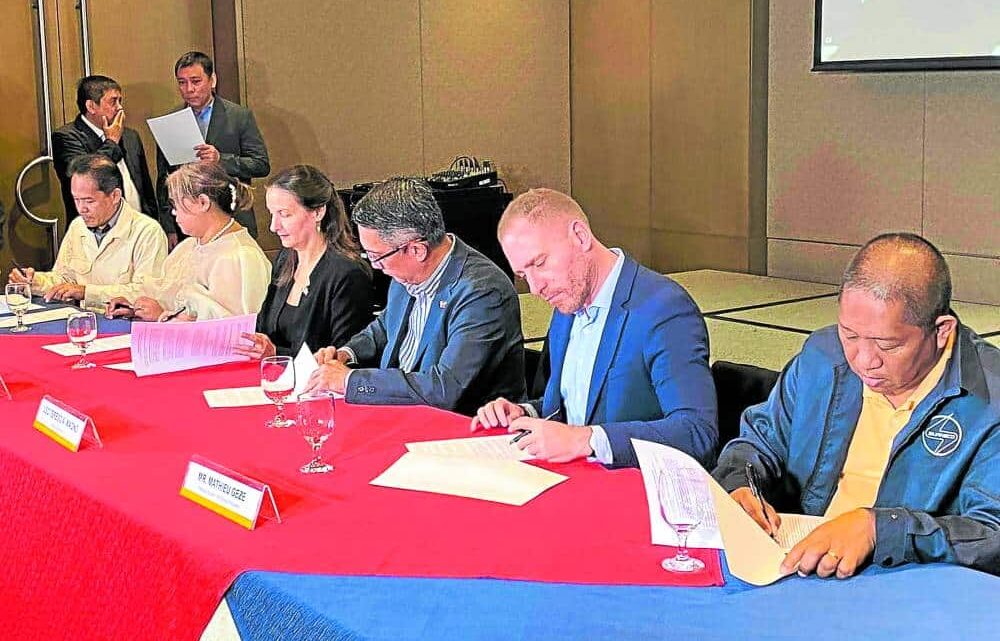
FOR CLEAN ENERGY A memorandum of cooperation is signed on July 19 between HDF Energy president Mathieu Geze (second from right) and representatives of the local governments of Surigao del Norte, Agusan del Sur and Zamboanga City. Also present as witnesses are France Ambassador Marie Fontanel and Mindanao Development Authority (MinDA) Secretary Leo Tereso Magno. —photo courtesy of MinDA
DAVAO CITY, Philippines — Green hydrogen, considered a clean source of energy since it is derived using a process powered by renewable sources like wind or sunlight, may soon gain more than just foothold but a transformative presence in the lives of Mindanaoans.
The French company Hydrogene De France (HDF) Energy is taking big steps to spread the technology to the region, starting in Olutanga Island in Zamboanga Sibugay and later in the provinces of Surigao del Norte and Agusan del Sur and Zamboanga City.
The long-term goal is to set up a total of 10 power plants in Mindanao and accelerate the region’s shift to renewables until they account for 50 percent of its energy mix by 2030.
READ: Growth of renewable energy not fast enough
Hydrogen power is produced through electrolysis, where electrical current is applied to split water molecules and separate the hydrogen from the oxygen components, with the former stored in tanks.
To produce green hydrogen, the apparatus used—called the electrolyser—is powered by renewable energy sources (in contrast, black, grey or brown hydrogen is produced using energy derived from fossil fuels like coal or natural gas).
Mathieu Geze, president and director of HDF Energy Philippines, said the company would put up either solar or wind power farms on-site both to run the electrolysers and directly supply power to the local grid.
On July 19, Geze and local government representatives of Zamboanga Sibugay, Surigao de Norte, Agusan del Sur and Zamboanga City signed a memorandum of cooperation (MOC) to facilitate coordination, information-sharing and technical studies leading to the setup of hydrogen power plants in the target areas.
Also present to witness the signing were Mindanao Development Authority (MinDA) Secretary Leo Tereso Magno and France’s ambassador to the Philippines, Marie Fontanel.
According to Geze, the initial projects are part of the 10 hydrogen power plants that HDF plans to put up in Mindanao in the coming years at an aggregate investment cost of roughly $1 billion.
Off-grid communities
Most of these projects would be located in hard-to-reach, off-grid communities or in towns and provinces with unstable power supply, Geze said at a media briefing after the signing.
Local officials welcomed the HDF Energy projects, expecting them to reduce electricity costs and address intermittent brownouts and unstable power supply in their areas.
In Surigao del Norte, for instance, people have been enduring unstable power supply and high electricity billings for the longest time, according to Rise Faith Recabo, the provincial administrator.
It is imperative to improve the power situation especially in the Siargao islands, the province’s primary tourist destination, Recabo said. “That’s why we welcome the project because once operational, it might help bring down power rates in our province.”
Trisha Goloran, head of the planning and development office of Agusan del Sur, said having a stable power supply was just as urgent in her province.
Raul Regondola, chair and administrator of the Zamboanga Economic Zone Authority, also said having a hydrogen power plant in Zamboanga City would also address the intermittent brownouts that occur “four to five times a day” even inside its 16,000-hectare special economic zone, which currently has 114 locators.
Once the plants are operational, HDF Energy will produce about 10 megawatts of hydrogen power for each site.
Where the need is real
Also at the MOC signing, Ambassador Fontanel said addressing climate change and boosting the transition to a green and sustainable future are high on the French government’s diplomatic agenda for international partners like the Philippines. France relies on expert companies like HDF Energy to fulfill this commitment, she said.
She said she was most impressed by HDF’s commitment to reach areas in Mindanao where the power situation must be addressed.
“So far, because not that many foreign companies do look at Mindanao [for] many reasons, security among them… HDF has decided precisely to look at those territories where there is a real need… I’m really impressed by the work already done by HDF,” Fontanel added.
MinDA Secretary Magno hailed the newly signed MOC as an achievement for the entire region.
Assistant Secretary Romeo Montenegro, the deputy executive director of MinDA, said the additional supply coming from HDF would help the regional government body meet its target of achieving a 50-50 renewable-to-fossil fuel energy ratio by 2030.
LGU cooperation crucial
Geze said HDF was currently in the process of securing the necessary government permits and negotiating with local cooperatives for eventual power distribution in the three provinces.
He said key to the project’s success would be the willingness of stakeholders, including the local government units, to provide the necessary support, like the identification and clearing of the land where the plants may be built.
In February this year, the Department of Energy (DOE) issued guidelines for hydrogen investment incentives in the country to promote sustainable energy solutions and reduce dependence on traditional fossil fuels.
According to DOE Circular No. 2024-01-0001, stakeholders engaged in hydrogen production, distribution, research and development, infrastructure establishment, and the operation of hydrogen fuel stations for the transport sector will enjoy various perks and incentives from the government, such as tax exemptions.